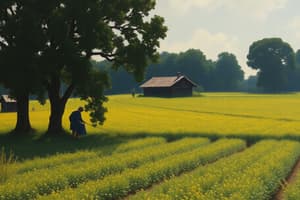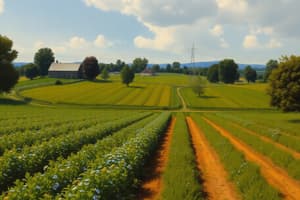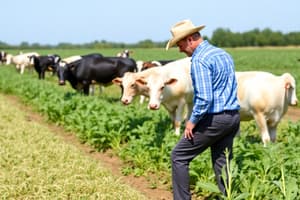Podcast
Questions and Answers
How do governmental interventions impact the competitiveness of agricultural markets, and can you provide an example?
How do governmental interventions impact the competitiveness of agricultural markets, and can you provide an example?
Governmental interventions like subsidies or price floors distort market signals, leading to inefficiencies. For instance, subsidies for corn production may result in overproduction, decreasing market prices.
What are the key differences between perfect competition and oligopoly in agricultural markets, and how do these structures affect pricing and output?
What are the key differences between perfect competition and oligopoly in agricultural markets, and how do these structures affect pricing and output?
Perfect competition involves many small firms, homogeneous products, and no market power, leading to prices reflecting production costs. Oligopoly involves a few large firms with market power, enabling them to influence prices and often restrict output.
Describe two strategies farmers can employ to mitigate the impact of climate change on their agricultural production.
Describe two strategies farmers can employ to mitigate the impact of climate change on their agricultural production.
Farmers can adopt drought-resistant crops and implement water conservation techniques like drip irrigation to mitigate climate change impacts.
Explain how increased globalization impacts local farmers in developing countries.
Explain how increased globalization impacts local farmers in developing countries.
How can technology adoption improve farm efficiency, and what are the potential barriers to technology adoption for small-scale farmers?
How can technology adoption improve farm efficiency, and what are the potential barriers to technology adoption for small-scale farmers?
How can the principles of supply and demand be applied to predict the impact of a drought on the price of a specific agricultural commodity, such as corn?
How can the principles of supply and demand be applied to predict the impact of a drought on the price of a specific agricultural commodity, such as corn?
Explain how understanding production theory can help a farmer decide the optimal amount of fertilizer to use on a wheat crop.
Explain how understanding production theory can help a farmer decide the optimal amount of fertilizer to use on a wheat crop.
Describe a scenario where government subsidies could lead to overproduction of a certain agricultural product and discuss the potential consequences.
Describe a scenario where government subsidies could lead to overproduction of a certain agricultural product and discuss the potential consequences.
How might a trade agreement that reduces tariffs on imported beef affect domestic beef producers and consumers?
How might a trade agreement that reduces tariffs on imported beef affect domestic beef producers and consumers?
Explain how advancements in agricultural technology, such as precision farming, can contribute to both increased food production and environmental sustainability.
Explain how advancements in agricultural technology, such as precision farming, can contribute to both increased food production and environmental sustainability.
Discuss the challenges small-scale farmers in developing countries might face in accessing agricultural markets and how this affects their livelihoods.
Discuss the challenges small-scale farmers in developing countries might face in accessing agricultural markets and how this affects their livelihoods.
How can understanding different types of costs (fixed and variable) influence a farmer's decision on whether to continue operating during a period of low commodity prices?
How can understanding different types of costs (fixed and variable) influence a farmer's decision on whether to continue operating during a period of low commodity prices?
Describe how the concept of economies of scale can impact the structure of the agricultural industry, particularly the size and number of farms.
Describe how the concept of economies of scale can impact the structure of the agricultural industry, particularly the size and number of farms.
Flashcards
Market Structures
Market Structures
Different systems like perfect competition and oligopoly that explain pricing in agriculture.
Risk in Agriculture
Risk in Agriculture
Factors such as weather and market changes that threaten food production.
Climate Change Impact
Climate Change Impact
Changes in weather patterns that challenge agricultural production.
Technology Adoption
Technology Adoption
Signup and view all the flashcards
Key Actors in Agriculture
Key Actors in Agriculture
Signup and view all the flashcards
Agricultural Economics
Agricultural Economics
Signup and view all the flashcards
Resource Allocation
Resource Allocation
Signup and view all the flashcards
Production Decisions
Production Decisions
Signup and view all the flashcards
Pricing and Marketing
Pricing and Marketing
Signup and view all the flashcards
Food Security
Food Security
Signup and view all the flashcards
Environmental Sustainability
Environmental Sustainability
Signup and view all the flashcards
Supply and Demand
Supply and Demand
Signup and view all the flashcards
Agricultural Technology
Agricultural Technology
Signup and view all the flashcards
Study Notes
Key Concepts
- Agriculture economics studies how societies decide on agricultural product production, distribution, and consumption. It uses economic principles to analyze these issues.
- It examines the actions of farmers, consumers, and other agricultural sector agents.
- The field uses theories like supply and demand, production, and market structures.
Scope of Agricultural Economics
- Resource Allocation: Optimizing land, labor, capital, and other agricultural resources.
- Production Decisions: Choosing crops, livestock, or other enterprises to maximize output and profits, considering input prices, technology, and market demand.
- Pricing and Marketing: Setting prices for agricultural products, creating efficient marketing systems, and assessing how market imperfections affect farm income.
- Farm Management: Planning and making decisions for farm businesses to efficiently utilize resources and increase profitability.
- Agricultural Policy: Analyzing government policies on agriculture, including subsidies, trade regulations, and environmental policies.
Key Issues in Agricultural Economics
- Food Security: Ensuring affordable, nutritious food for everyone, involving efficient production, storage, and distribution.
- Environmental Sustainability: Balancing agricultural production with environmental concerns (soil erosion, water pollution, biodiversity loss).
- Agricultural Trade: The effect of international trade on agricultural markets and farmer incomes, including imports/exports, trade liberalization, and protectionism.
- Rural Development: Supporting economic growth in rural communities.
- Agricultural Technology: Exploring the role of technological advances (seeds, fertilizers, machinery) in shaping agricultural production.
Economic Principles in Agriculture
- Supply and Demand: How supply and demand interact to determine market prices, output, and farmer profits.
- Production Theory: Analyzing input-output relationships (land, labor, capital, and agricultural products), understanding diminishing returns and economies of scale.
- Cost and Revenue: Examining cost types (fixed, variable, total, marginal) and revenue influences, focusing on balancing them for profit.
- Market Structures: Understanding market behaviour and pricing trends (perfect competition, monopolistic competition, oligopoly) in diverse agricultural sectors recognizing how concentrated production and government intervention often deviate from perfect competition in agriculture.
- Risk and Uncertainty: Recognizing agricultural production's vulnerability to weather, market fluctuations, and disease outbreaks, highlighting the need for risk management.
Current Trends and Challenges
- Climate Change: Changing rainfall patterns, extreme weather, and temperature changes, creating challenges for agricultural production. Adaptation and climate-resilient practices are vital.
- Globalization: Increased trade liberalization and global interconnectedness offer opportunities but also bring challenges of competition and global market volatility.
- Technology Adoption: Technological advancements offer potential for increased output, optimized resource use, and improved farm efficiency, but adoption rates often vary across regions and farms.
Key Actors in Agriculture
- Farmers: Primary agricultural product producers.
- Consumers: Agricultural product buyers.
- Government Agencies: Formulate policies and regulations affecting agricultural production and market dynamics.
- Agribusiness Firms: Wholesalers, retailers, and other entities involved in agricultural product distribution.
Conclusion
- Agriculture economics is a complex field with interconnected components.
- It addresses the complexities of resource allocation, production patterns, and economic behaviour in the agricultural sector.
- It plays a vital role in global food security and sustainability.
Studying That Suits You
Use AI to generate personalized quizzes and flashcards to suit your learning preferences.




